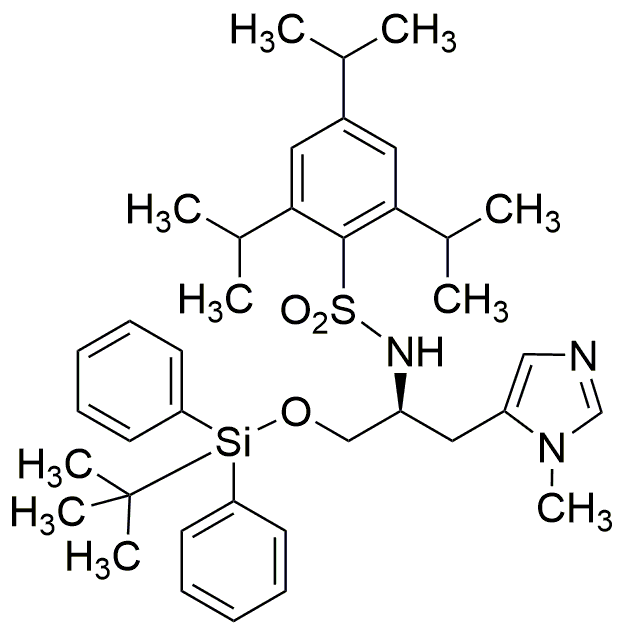Na-(2,4,6-Triisopropylbenzenesulfonyl)-O-(tert-butyldiphenylsilyl)-p-methyl-L-histidinol is widely utilized in research focused on:
- Pharmaceutical Development: This compound serves as a key intermediate in synthesizing various pharmaceuticals, particularly those targeting neurological disorders, enhancing drug efficacy.
- Biochemical Research: It is used in studies involving enzyme inhibition, allowing researchers to explore metabolic pathways and develop potential therapeutic agents.
- Material Science: The compound's unique properties make it suitable for creating advanced materials, including polymers and coatings that require specific chemical resistance.
- Analytical Chemistry: It acts as a reagent in chromatography, aiding in the separation and identification of complex mixtures, which is crucial for quality control in laboratories.
- Biotechnology: This chemical is applied in the modification of biomolecules, improving the stability and functionality of proteins in various biotechnological applications.
General Information
Properties
Safety and Regulations
Applications
Na-(2,4,6-Triisopropylbenzenesulfonyl)-O-(tert-butyldiphenylsilyl)-p-methyl-L-histidinol is widely utilized in research focused on:
- Pharmaceutical Development: This compound serves as a key intermediate in synthesizing various pharmaceuticals, particularly those targeting neurological disorders, enhancing drug efficacy.
- Biochemical Research: It is used in studies involving enzyme inhibition, allowing researchers to explore metabolic pathways and develop potential therapeutic agents.
- Material Science: The compound's unique properties make it suitable for creating advanced materials, including polymers and coatings that require specific chemical resistance.
- Analytical Chemistry: It acts as a reagent in chromatography, aiding in the separation and identification of complex mixtures, which is crucial for quality control in laboratories.
- Biotechnology: This chemical is applied in the modification of biomolecules, improving the stability and functionality of proteins in various biotechnological applications.
Documents
Safety Data Sheets (SDS)
The SDS provides comprehensive safety information on handling, storage, and disposal of the product.
Product Specification (PS)
The PS provides a comprehensive breakdown of the product’s properties, including chemical composition, physical state, purity, and storage requirements. It also details acceptable quality ranges and the product's intended applications.
Certificates of Analysis (COA)
Search for Certificates of Analysis (COA) by entering the products Lot Number. Lot and Batch Numbers can be found on a product’s label following the words ‘Lot’ or ‘Batch’.
*Catalog Number
*Lot Number
Certificates Of Origin (COO)
This COO confirms the country where the product was manufactured, and also details the materials and components used in it and whether it is derived from natural, synthetic, or other specific sources. This certificate may be required for customs, trade, and regulatory compliance.
*Catalog Number
*Lot Number
Safety Data Sheets (SDS)
The SDS provides comprehensive safety information on handling, storage, and disposal of the product.
DownloadProduct Specification (PS)
The PS provides a comprehensive breakdown of the product’s properties, including chemical composition, physical state, purity, and storage requirements. It also details acceptable quality ranges and the product's intended applications.
DownloadCertificates of Analysis (COA)
Search for Certificates of Analysis (COA) by entering the products Lot Number. Lot and Batch Numbers can be found on a product’s label following the words ‘Lot’ or ‘Batch’.
*Catalog Number
*Lot Number
Certificates Of Origin (COO)
This COO confirms the country where the product was manufactured, and also details the materials and components used in it and whether it is derived from natural, synthetic, or other specific sources. This certificate may be required for customs, trade, and regulatory compliance.


